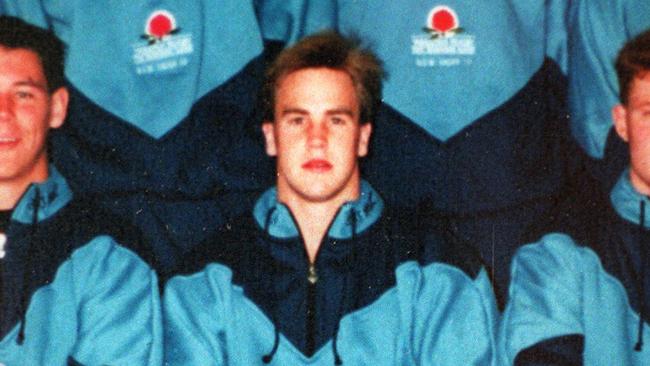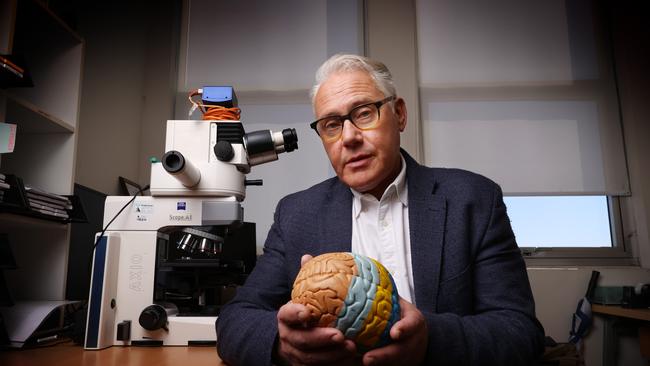Former Sydney schoolboy revealed as Australia’s first diagnosed case of CTE in a rugby player
Ian Tucker played rugby at Sydney’s prestigious boys’ school St Ignatius College Riverview and died in 1996 at the age of 23. Nailing down his CTE diagnosis has taken more than 25 years.

A former Sydney schoolboy has been revealed as Australia’s first diagnosed case of CTE in a rugby player, experts say.
Ian Tucker played rugby at Sydney’s prestigious boys’ school St Ignatius College Riverview and died in 1996 at the age of 23 after making a try-saving tackle playing for Oxford University.
At the coronial inquest into his death, a London Coroner found Tucker had two concussions 10 days apart, causing the fatal brain injury Second Impact Syndrome.
Nailing down Tucker’s CTE diagnosis has taken more than 25 years. In 1999, experts suggested his brain showed signs of dementia pugilistica (now known as CTE) – a progressive degeneration of the brain seen in “punch drunk” boxers.
However on this occasion, Tucker was misidentified as a footballer who “regularly headed balls”.
Twenty-four years later, in 2023, Tucker’s brain was once more under the microscope – and this time correctly diagnosed with low-stage CTE and correctly identified this time as an amateur rugby player.
News of the CTE diagnosis has sent the Tucker family reeling for a second time since his death in 1996.
“To think that Ian possibly had CTE for four or five years before he died, well that was a shock,” an emotional brother, George Tucker, told the Weekend Australian.
Tucker said he had a premonition his brother was going to be killed in his last game.
“The coroner said he had a lesion in his brain ... the way I see it, it was waiting to be popped,” he said.
Tucker said he didn’t want contact sport to end because it provided enormous benefits – he himself played rugby for 35 years.
But he urged rugby administrators to do more to protect younger players who thought they were “invincible”.
“There are things that can be done to make the game safer, and I hope the organisations running the sport take it seriously,” Tucker said.
There was a need to reduce contact training sessions, Tucker said.
“It’s just not necessary to have so many ‘smash-up’ sessions – because that’s what they are,” he said.
Ian Tucker started playing rugby in Year 6 at St Ignatius College and continued until his graduation. A gifted player, he was selected in the Australian under-19s and played for NSW schoolboys before turning out for Sydney University and then undertaking postgraduate studies at Oxford University in the UK.
“Ian would have loved to get into the Wallabies,” George said. “He was fearless and no one trained harder.”
‘ANY CTE IS A WORRY’
“There wasn’t much CTE in Ian’s brain,” said Professor William Stewart, who diagnosed Tucker. “But at 23, any CTE is a worry,” he said.
Stewart, a consultant neurologist at the Queen Elizabeth Hospital in Glasgow who advises the Professional Footballers Association and the Football Association, says it’s not known how common CTE is or why some develop the disease and others don’t.

“We should worry about what Ian’s future might have held if he had not been killed,” Stewart said.
“Maybe he would have been none the wiser and symptom free. But what we do know is that rugby players have a two-to-three-fold increased risk of dementia.
“CTE smoulders away for decades in the brain and then it turns up in 50- or 60-year-olds, who then turn up at dementia clinics,” he said.
SECOND CASE
Tucker is now the second case of CTE in a former Sydney schoolboy who played rugby. In 2022, more than 25 years after Tucker’s death, 20-year-old NRL rookie Keith Titmuss died from extreme heat exhaustion at the Manly Sea Eagles’ training facility on Sydney’s northern beaches. A subsequent brain examination revealed he had CTE.
“We know CTE has been in footballers for decades,” Dr Michael Buckland from the Australian Sports Brain Bank told the Weekend Australian. “But we just don’t know what the toll is.”
Like Tucker, Titmuss attended an elite GPS boys’ school, this time Newington College, whose motto is “rugby runs through our veins”.

After Titmuss was diagnosed, Buckland said this case should be a “wake-up call” to parents and send a message to schools to ban tackling for children until they are at least 12.
However, Rugby Australia said going down that path could have unintended consequences.
“We take the view (that lowering the tackle age) carries greater risk to players as it means that players would be learning to tackle too late and at a time when there is greater variation across players in size and strength,” Rugby Australia said.
That statement drew the ire of Stewart, who says footballers are facing “phenomenal risks” from their exposure to head injury, with the greatest risks for those who start young.
“Tacking is not brain science,” he said. “Twelve- and 13-year-olds can learn about tackling as much as eight-year-olds.
Stewart, who diagnosed CTE in ex-England and West Bromich Albion striker Jeff Astle, claimed: “Rugby is full of headlines, but the reality is they are doing nothing. Rugby needs to rethink if it wants to evolve into a heavy contact and collision game or does it want to make the sport attractive to parents? At the moment, what they are selling is not attractive to parents.”
But the game denies this, citing a suit of changes designed to make rugby safer, including a ban on high hits, concussion protocols and a trial to reduce tackle heights.
“Reducing tackle heights – that’s another headline,” Stewart said. “If they were serious, the injury rates would be coming down. It’s no good falling back on the concussion protocols because they’ve made no difference. Are we really sacrificing men to follow the concussion protocols?”
In response to Tucker’s CTE diagnosis, St Ignatius principal Dr Paul Hine said Ian Tucker was fondly remembered as a distinguished alumnus who exemplified academic and athletic excellence. Boys playing rugby completed safe-tackle training with strict concussion protocols, and the school endorsed RA’s new tackling protocols. St Ignatius College has 46 rugby teams.

But tensions between CTE experts and professional collision sport show no sign of abating, with the latest furore over World Rugby implying CTE experts have endorsed their policy on CTE.
In a statement provided via RA, World Rugby says it met last year with CTE experts to discuss World Rugby’s CTE “position statement”.
The statement “was reviewed ... with the Boston University CTE Group and members of the Concussion Legacy Foundation in 2023” said World Rugby, with “agreement between these groups that no alterations were required to this position statement”.
Boston University and the Concussion Legacy Foundation disagree .
“CLF has never been formally asked to endorse any World Rugby statements on CTE and we do not,” CLF founder Dr Chris Nowinski told the Weekend Australian.
Dr Ann McKee, a neurologist from Boston University, also stated there was “no discussion” of the paper in question, and while she did make a presentation on her CTE research, she was “dismissed” immediately afterwards.

“The International Rugby Board has a long history of denying and obfuscating the scientific data showing that repetitive head impacts in contact sports are linked to CTE, including the recent evidence that CTE risk is associated with years of play in rugby union players,” McKee said.
“The risk for CTE posed by repetitive head impacts in contact sports, including boxing, football, ice hockey, soccer, and rugby, is real and incontrovertible.”
Asked to provide evidence, World Rugby pointed to the following statement in a recent document.
“The World Rugby Concussion Working Group has recently interrogated the evidence base that informs our head injury prevention and management protocols. This included convening a multidisciplinary meeting during which experts presented evidence ... including (BU Presentations) on chronic traumatic encephalopathy.”
Nowinski told the Weekend Australian: “I assume it has to be a miscommunication. CLF would welcome a direct dialogue with Rugby Australia leadership so this doesn’t happen in the future.”



To join the conversation, please log in. Don't have an account? Register
Join the conversation, you are commenting as Logout